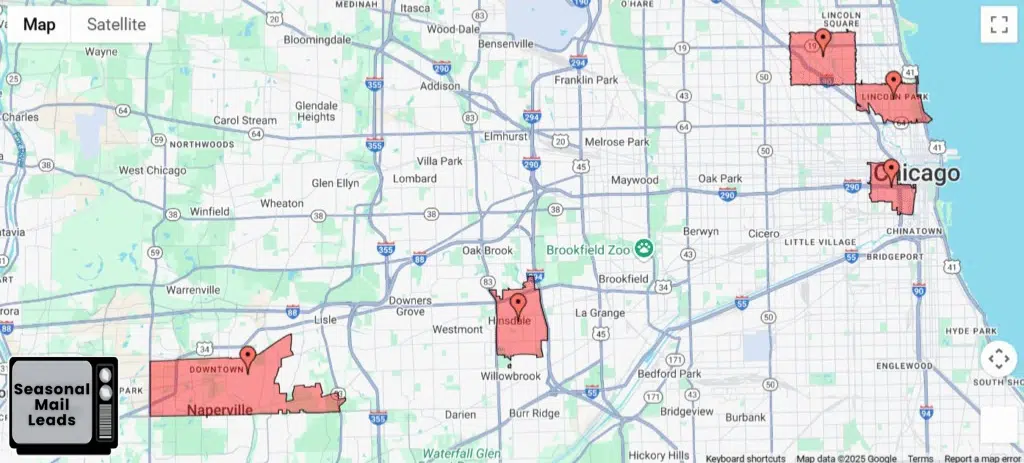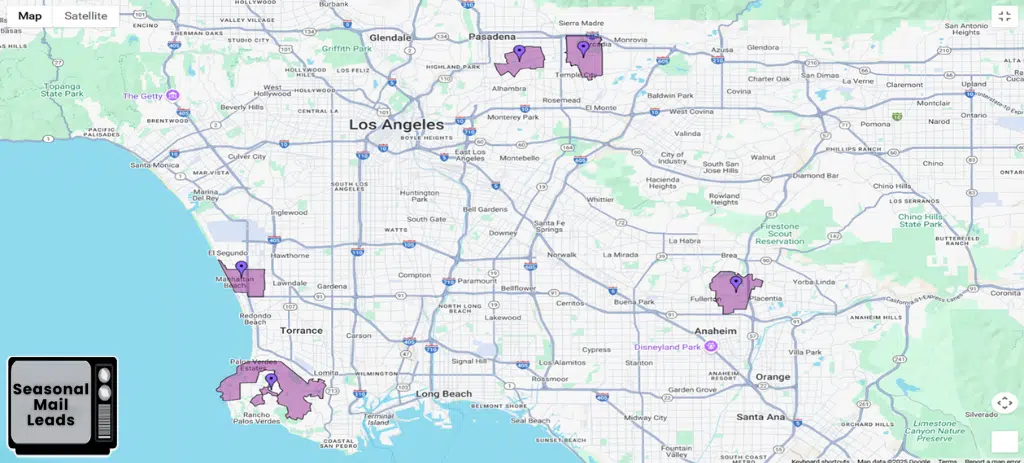
Family Law Direct Mail: Assisting Homeowners During Transitions and New Beginnings – Lead Generation
1. Introduction: Targeted Direct Mail for Family Law Leads
The acquisition of a new home is frequently synonymous with a fresh start, a symbol of stability, and the foundation for exciting new chapters. However, this period of significant change can also bring to the forefront, perhaps paradoxically, unforeseen family transitions and complex legal considerations. From the excitement of a blended family moving into a shared space to the unforeseen strains that can lead to separation, new homeowners often find themselves navigating a landscape ripe with potential family law needs. How effectively is your firm reaching these individuals, offering the compassionate and essential legal guidance they require during such pivotal life moments?
In a legal marketplace saturated with generalized advertising, targeted direct mail stands out as a uniquely compassionate and highly effective method to generate Family Law leads from new homeowners. By offering timely and essential legal guidance, this strategy allows your firm to connect with individuals precisely when they are most receptive to support during significant life changes. This article will thoroughly explore how the status of being a new homeowner can intimately intersect with various family law needs and provide a comprehensive guide on how to craft direct mail campaigns that not only offer crucial support but also convert these prospects into valued clients. This is your ultimate playbook for family legal services.
2. Why New Homeowners May Need Family Law Services
The act of purchasing a new home is a profound life event, often occurring alongside, or even precipitating, other significant personal transitions. These transitions frequently bring individuals face-to-face with complex family law scenarios they hadn’t anticipated. Understanding these intersections is key to effective outreach for new homeowner family legal needs.
2.1. New Environments & Relocations Impacting Custody Arrangements
Moving to a new city or state is a common consequence of purchasing a new home, especially for those relocating for work or family. While exciting, these geographical shifts can create substantial legal complexities for families, particularly concerning existing custody arrangements or the necessity of filing for divorce in an unfamiliar jurisdiction.
Impact on Existing Custody Orders: For parents with existing child custody orders or visitation schedules, a relocation can complicate adherence to these arrangements. Often, moving across state lines or even within the same state (but a significant distance) requires seeking a court modification of the existing order. This process is highly nuanced, often involving demonstrating a “material change in circumstances” and proving that the move is in the child’s best interest. New homeowners in this situation urgently need legal counsel familiar with interstate jurisdictional rules (e.g., the Uniform Child Custody Jurisdiction and Enforcement Act – UCCJEA) for custody order modifications relocation.
Jurisdictional Challenges for Divorce Filings: If a marriage is dissolving or already dissolved, establishing residency requirements for a divorce filing in a new state can be complex. Each state has specific durational residency requirements before a divorce petition can be filed. Furthermore, new residents might be unfamiliar with their new state’s specific family law statutes regarding property division, spousal support, or child support calculations. A local family law attorney becomes indispensable for navigating these new jurisdictional nuances.
Enforcement of Out-of-State Orders: Even if a divorce or custody order was finalized in a previous state, it may need to be registered or domesticated in the new state for local enforcement. New homeowners may discover this requirement only when a dispute arises, prompting an urgent need for legal assistance.
2.2. Blended Families & Pre-Nuptial/Post-Nuptial Agreements
The purchase of a new home, often a significant shared asset, can naturally prompt discussions about asset protection, financial planning, and the need for formal agreements in blended families or new/second marriages. This is particularly true when there are children from prior relationships.
Securing New Assets: For couples entering a new marriage or already in one, the acquisition of a new, substantial asset like a home often triggers discussions about how this asset should be managed, especially in the event of death or divorce. This is where pre-nuptial agreements (before marriage) or post-nuptial agreements (during marriage) become crucial, especially for a pre-nuptial agreements new home scenario.
Protecting Children’s Inheritance: In blended families, homeowners frequently want to ensure that their children from a previous relationship inherit a portion of their assets, including the new home, without inadvertently disinheriting them due to a new marriage. Pre- or post-nuptial agreements can clearly delineate separate and marital property, providing clarity and protection. This also ties into estate planning blended families.
Defining Marital vs. Separate Property: A pre-nuptial or post-nuptial agreement can explicitly define the new home as either separate property of one spouse (if, for example, it was purchased with funds from a prior separate asset) or clearly designate it as marital property. This foresight can prevent contentious property division disputes in the future.
Clarity for Step-Parents: These agreements can also address financial responsibilities, child support for children from prior relationships, and other considerations pertinent to the unique dynamics of blended families.
2.3. Estate Planning Overlaps & Family Dynamics
The purchase of a new home inherently shifts focus to estate planning, particularly concerning who will inherit the property and how it will be managed. This naturally brings up intersections with family law, especially regarding guardianship, marital property, and the impact of evolving family dynamics on existing or future estate plans.
Guardianship for Minor Children: For parents purchasing a home, the natural next step is to consider who would care for their minor children if something were to happen to both parents. This necessitates a guardianship nomination within a will or a comprehensive estate plan, a core component of family law planning and crucial for child guardianship new home planning.
Marital Property Considerations: The characterization of the new home as marital property or separate property can have significant implications in both divorce and estate distribution. Understanding community property versus equitable distribution laws is critical. Attorneys can advise on title (e.g., joint tenancy, tenants by the entirety, community property with right of survivorship) to align with familial intentions and minimize future disputes.
Updating Existing Estate Plans: For homeowners who already have a will or trust, a new home purchase (especially across state lines) or changes in marital status (new marriage, separation) often necessitates a complete review and update of their existing estate plan. Failure to do so can lead to unintended beneficiaries or the probate court distributing assets contrary to the homeowner’s wishes. This is particularly relevant for estate planning blended families.
Financial Power of Attorney/Healthcare Directives: Beyond the will, the new home purchase might prompt homeowners to consider general powers of attorney or healthcare directives, especially as they envision the long-term future within their new dwelling.
2.4. Life Transitions & Relationship Structures
The emotional and financial intensity of buying a new home can sometimes coincide with, or even bring to a head, existing tensions within a relationship, leading to discussions about separation, divorce, or new relationship structures.
Stress and Strain: The financial strain of a new mortgage, the stress of moving, and the emotional investment in a “new beginning” can exacerbate pre-existing marital issues. What was once tolerable tension might become unbearable pressure.
Redefined Priorities: A new home can lead couples to re-evaluate their long-term goals and individual happiness. For some, the new environment provides a fresh perspective that highlights dissatisfaction with the current relationship structure.
New Relationship Structures: For unmarried couples purchasing a home together, the significant shared asset might prompt discussions about formalizing their partnership through domestic partnership agreements or cohabitation agreements to define property rights and responsibilities, especially if their relationship were to end.
Separation or Divorce: In more challenging scenarios, the “new beginning” promised by a home might sadly coincide with the end of a relationship, leading to discussions about separation or divorce. The new home itself then becomes a significant asset that needs to be legally divided, requiring expert family law counsel for divorce filings new property.
3. Targeting Family Law Leads Through Direct Mail: Sensitive & Strategic Approaches
Generating Family Law leads from new homeowners requires an approach that is both highly strategic and deeply sensitive. Direct mail, when executed by experts like Seasonal Mail Leads, excels in this arena by allowing for precise targeting and the delivery of compassionate, private messages, driving strong family law leads direct mail results.
3.1. Demographic Filtering for Precision Targeting
Precision targeting is paramount in Family Law to ensure your outreach is relevant and respectful. We leverage sophisticated demographic data to identify new homeowners who are most likely to have coinciding family law needs:
Marital Status & Recent Marriages: Targeting individuals based on recent marriage records alongside home purchases can identify couples who might need pre-nuptial or post-nuptial agreements to secure their new assets, including those for a pre-nuptial agreements new home or post-nuptial agreements new home.
Presence and Ages of Children: The presence of minor children (especially young children) is a strong indicator of a need for guardianship planning in an estate context. Families with teenage children might be considering college planning or emancipation issues in the context of relocation. This informs child guardianship new home services.
Family Size & Dynamics: Larger families or those indicating multi-generational households might have more complex estate planning or guardianship needs.
Recent Divorce Filings/Remarriages (Public Records): While sensitive, public records of recent divorces or remarriages (especially if followed by a new home purchase) can indicate a need for post-divorce modifications, custody order adjustments due to relocation, or pre-nuptial agreements for subsequent marriages. This helps pinpoint custody order modifications relocation.
Income Levels & Home Value: Filtering by income or home value can help target clients who require more sophisticated asset protection or have complex financial situations necessitating specialized family law expertise.
This granular demographic filtering allows your firm to send direct mail that feels highly relevant and timely, not intrusive or random, enhancing your targeted family law marketing.
3.2. Messaging Focused on Support, Stability, and Future Planning
The tone and content of your direct mail messaging for Family Law must be empathetic, supportive, and solution-oriented, focusing on positive outcomes like stability and future security, rather than dwelling on conflict. This offers crucial legal guidance life transitions.
Compassionate Language: Use warm, understanding language. Phrases like “Navigating life’s changes,” “Supporting your family’s future,” or “Guidance for your new beginning” set a supportive tone.
Focus on Peace of Mind: Emphasize how legal planning can bring stability. “Secure your children’s future with clear guardianship plans,” “Achieve peace of mind with a comprehensive pre-nuptial agreement.”
Proactive Planning: Frame your services as a proactive step to ensure family harmony and prevent future disputes. “Plan ahead to protect your new home and family,” “Ensure a smooth transition during life’s milestones.”
Confidentiality Assured: Explicitly state that all consultations are confidential and non-judgmental, which is crucial for sensitive family law matters.
Solution-Oriented: While acknowledging potential challenges, the messaging should always pivot to the positive solutions your firm provides. Instead of “avoiding divorce,” it’s “navigating separation with dignity.”
This empathetic framing helps new homeowners feel understood and trust your firm with their sensitive new homeowner family legal needs.
3.3. Offers for Confidential Consultations or Family Legal Checklists
To encourage response, your direct mail offers must be low-barrier, highly valuable, and respect the private nature of family law matters.
Private, Confidential Consultation: Offer a “Complimentary & Confidential Consultation” Complimentary & Confidential Consultation to discuss their specific family law concerns related to their new home. Emphasize discretion.
Family Legal Health Checklist: Provide a free downloadable “New Homeowner’s Family Legal Health Checklist” New Homeowner’s Family Legal Health Checklist or “Family Transition Planning Guide” Family Transition Planning Guide that helps them identify potential legal needs related to their new home and family structure.
Webinar/Seminar Invitation: Host a discreet online seminar on “Legal Planning for Blended Families” Legal Planning for Blended Families or “Relocating with Existing Custody Orders” Relocating with Existing Custody Orders, offering valuable information in a low-pressure environment.
Online Assessment Tool: Direct them to a confidential online quiz or assessment that helps them determine if they have specific family law needs.
These offers provide a valuable entry point, allowing new homeowners to seek initial guidance without feeling exposed or committed.
4. Designing Empathetic Direct Mail for Family Law: Building Trust
For Family Law, the visual and emotional appeal of your direct mail is as critical as the message itself. The design must build trust and convey a sense of empathy, support, and privacy.
4.1. Warm, Professional, and Non-Judgmental Tone
Every element of the mailer, from typeface to imagery, should contribute to a feeling of warmth, professionalism, and understanding.
Soft Color Palettes: Utilize calming and inviting colors (e.g., soft blues, greens, neutrals) rather than harsh or aggressive tones.
Approachable Fonts: Choose legible, friendly fonts that convey a sense of approachability and readability.
Balanced Professionalism: While maintaining a professional appearance appropriate for a law firm, avoid overly formal or intimidating legalistic designs. The goal is to be seen as a trusted advisor, not just a litigator.
Direct, Empathetic Addressing: Address the recipient directly with a tone that suggests understanding and a willingness to help, without presuming their specific situation.
This holistic approach creates a welcoming impression that encourages prospects to reach out.
4.2. Clear, Respectful Language Addressing Sensitive Topics
The challenge in Family Law direct mail is discussing potentially sensitive topics (divorce, custody) with tact and clarity, focusing always on positive outcomes and respect.
Focus on Solutions and Outcomes: Instead of using words like “divorce battle,” opt for “navigating separation with dignity” or “achieving an amicable resolution.” For custody, emphasize “securing your child’s best interests” or “establishing stable arrangements.” This offers critical legal guidance life transitions.
Child-Centric Language: If children are a factor, center the language around their well-being and stability. “Ensuring a stable future for your children.”
Neutral and Informative: Provide information in a neutral, objective manner, avoiding loaded language or emotional triggers. Present your firm as a source of impartial, expert guidance.
Privacy Assurances: Reiterate the confidentiality of their outreach and your services.
This careful choice of language demonstrates your firm’s sensitivity and professionalism, crucial for building trust in deeply personal legal matters.
4.3. Visuals that Convey Support, Harmony, and Privacy
The right visuals can instantly communicate the empathetic and trustworthy nature of your firm.
Calming and Reassuring Imagery: Use images that evoke peace, stability, and support. This could include abstract designs with flowing lines, images of hands gently supporting each other, or serene landscapes.
Subtle Family Representations: If using family imagery, opt for diverse, authentic, and non-idealized depictions. Focus on connection and harmony rather than overly posed, perfect families, which can alienate those in distress. Alternatively, focus on the home itself as a place of safety and future.
Professional, Approachable Staff Photos (if applicable): If including photos of attorneys, ensure they convey approachability, empathy, and professionalism.
Emphasis on Privacy: Visual elements can subtly reinforce privacy, such as imagery that suggests a safe, confidential space for discussion.
By aligning visuals with the message of support and discretion, your direct mail becomes a powerful, empathetic invitation for homeowners to seek guidance during their significant life transitions.
5. Measuring ROI for Family Law Direct Mail Campaigns
Accurately measuring the return on investment (ROI) for Family Law direct mail campaigns is essential for optimizing your marketing strategy and demonstrating tangible value. Seasonal Mail Leads provides the frameworks and tools to track your success meticulously, even for sensitive inquiries, proving the effectiveness of family law leads direct mail.
5.1. Tracking Confidential Inquiries & Consultations
The first step in calculating ROI is to monitor all inbound inquiries and scheduled consultations that result directly from your direct mail campaigns. Given the sensitive nature of Family Law, this tracking must be handled with the utmost discretion and efficiency.
Dedicated & Trackable Contact Methods: Utilize unique, dedicated phone numbers for each direct mail campaign to precisely attribute call volume. Similarly, provide specific landing page URLs or QR codes that direct to confidential inquiry forms or booking pages on your website, allowing for precise web traffic tracking.
Confidential Intake Process: Ensure your firm’s intake process is designed to handle sensitive inquiries empathetically and efficiently. Train staff to log the source of each inquiry (e.g., “Direct Mail – Family Law Campaign”) and to ask non-intrusive questions that gather necessary information while respecting privacy.
Consultation Scheduling & Tracking: Monitor the number of inquiries that convert into scheduled initial consultations. This is a critical metric for assessing the effectiveness of your mailer’s call to action and offer.
CRM Integration: Seamlessly integrate all inquiry data into your Customer Relationship Management (CRM) system. This allows you to track the entire client journey, from initial contact through to retention, ensuring no lead is lost.
This meticulous tracking provides immediate insights into the quantity and quality of leads generated by your direct mail efforts, providing a clear picture of initial engagement.
5.2. Client Acquisition Costs vs. Long-Term Case Value
The true ROI in Family Law is realized when inquiries convert into retained clients, especially considering the often significant long-term case value of these matters.
Cost Per Lead (CPL): Calculate your Cost Per Lead by dividing the total campaign cost by the number of qualified inquiries received. This metric helps assess the efficiency of your lead generation.
Cost Per Acquisition (CPA): More importantly, determine your Cost Per Acquisition by dividing the total campaign cost by the number of actual clients retained. This metric is a direct measure of your marketing efficiency in acquiring paying clients.
Average Case Value (ACV): Family Law cases can vary significantly in value (e.g., a simple pre-nuptial agreement versus a complex, litigated divorce with property division and child custody). Calculate the Average Case Value for different types of family law cases acquired through direct mail. This helps you understand the revenue generated per client.
Lifetime Client Value (LCV): In Family Law, clients often return for modifications (e.g., custody order modifications, child support adjustments) or refer family and friends. While harder to quantify precisely, consider the potential Lifetime Client Value, which can significantly boost the ROI beyond the initial retainer.
ROI Calculation: Compare your total revenue from direct mail-acquired clients against the total campaign cost. A strong ROI demonstrates that your investment is yielding substantial returns. For example, if a campaign cost $5,000 and resulted in clients generating $20,000 in revenue, your ROI is 300%.
By focusing on these metrics, your firm can make data-driven decisions to optimize future direct mail campaigns, refine offers, and streamline your intake process, maximizing both short-term revenue and long-term client relationships.
5.3. Case Study/Example
Case Study: Family Law Success with Targeted Direct Mail
Consider “Family Path Legal,” a firm specializing in divorce, custody, and pre-nuptial agreements. They partnered with Seasonal Mail Leads to launch a compassionate direct mail campaign targeting new homeowners (purchased within the last 9 months) who either had minor children or were in their second marriage.
Seasonal Mail Leads designed a subtle, elegant postcard with the headline: “Your New Home, Your Family’s Future: Legal Guidance for Life’s Transitions.” The mailer offered a “Confidential Family Legal Check-Up” – a free, private phone consultation or a downloadable checklist for family legal planning. A dedicated phone number and a private URL with a QR code were provided for response.
Over a three-month period, Family Path Legal received 120 confidential inquiries, representing a 2.0% response rate. From these, 70 scheduled initial consultations, and 20 converted into retained clients. The cases varied, including 4 pre-nuptial agreements related to their new home, 8 custody order modifications due to relocation, and 8 divorce filings where the new property was a primary asset. The average case value for these clients was approximately $5,500, resulting in $110,000 in new revenue from a campaign cost of $6,000. This yielded an impressive ROI of 1733%, clearly demonstrating the power of empathetic, targeted direct mail in connecting with new homeowners for their Family Law needs.
Start Your Summer Legal Leads Campaign Today
Secure your exclusivity. Limited spots available per city for law firm marketing.
10-Week Program: Designed for steady call flow & bar association compliance.
Exclusive Access: Limited spots per city/area to protect your market for attorney leads.
Two Plans: New Client Plan & Returning Client Renewal for postcard marketing campaigns.
Pricing Snapshot:
New Client Plan: Just $103.99 every week (total 16 weeks).
Returning Client Renewal: Only $83.99 every week (total 16 weeks).
6. Call to Action: Targeted Family Law Marketing
Ready to connect with new homeowners needing sensitive Family Law guidance during their life transitions?
Request Your FREE Sample Postcard Request Your FREE Sample Postcard specifically designed for Family Law.
Discuss Your Compassionate Family Law Lead Strategy Discuss Your Compassionate Family Law Lead Strategy with our experts, focusing on targeted family law marketing.
Let Seasonal Mail Leads help your firm become the trusted resource for families navigating their new beginnings, building a sustainable and impactful client base.
7. Conclusion: Exclusive Legal Leads Through Targeted Direct Mail
The journey of new homeowners is often intertwined with significant family transitions, creating a profound and consistent need for empathetic and expert family law guidance. While digital channels can be impersonal, direct mail emerges as a uniquely powerful and compassionate tool for connecting with these individuals precisely when they are most receptive to thoughtful legal support.
Seasonal Mail Leads specializes in providing innovative and respectful lead generation solutions for Family Law. By meticulously identifying new homeowners based on their demographic and life circumstances, crafting messages that prioritize support, stability, and privacy, and ensuring clear, confidential pathways to engagement, your firm can establish itself as the go-to resource for families navigating their new beginningsand life transitions.
It’s time to move beyond generalized marketing. Embrace the ultimate playbook. Discover how targeted direct mail, powered by Seasonal Mail Leads, can consistently deliver the exclusive legal leads your firm needs to thrive and genuinely support families through every chapter of their new home journey.






